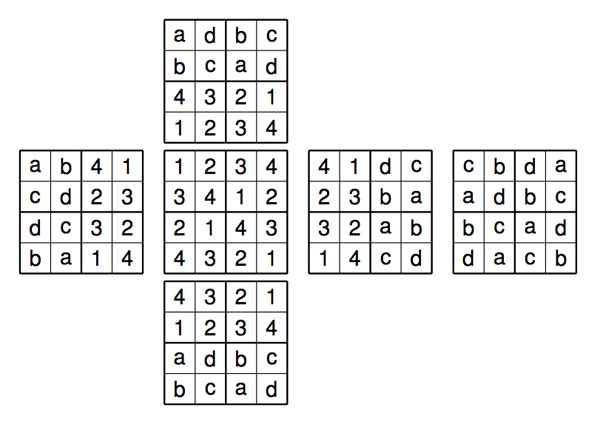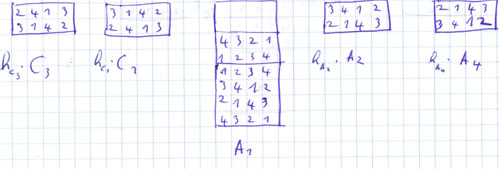The adelic interpretation of the Bost-Connes Hecke algebra $\mathcal{H} $ is based on three facts we’ve learned so far :
-
The diagonal embedding of the rational numbers $\delta~:~\mathbb{Q} \rightarrow \prod_p \mathbb{Q}_p $ has its image in the adele ring $\mathcal{A} $. ( details )
-
There is an exact sequence of semigroups $1 \rightarrow \mathcal{G} \rightarrow \mathcal{I} \cap \mathcal{R} \rightarrow \mathbb{N}^+_{\times} \rightarrow 1 $ where $\mathcal{I} $ is the idele group, that is the units of $\mathcal{A} $, where $\mathcal{R} = \prod_p \mathbb{Z}_p $ and where $\mathcal{G} $ is the group (!) $\prod_p \mathbb{Z}_p^* $. ( details )
-
There is an isomorphism of additive groups $\mathbb{Q}/\mathbb{Z} \simeq \mathcal{A}/\mathcal{R} $. ( details )
Because $\mathcal{R} $ is a ring we have that $a\mathcal{R} \subset \mathcal{R} $ for any $a=(a_p)_p \in \mathcal{I} \cap \mathcal{R} $. Therefore, we have an induced ‘multiplication by $a $’ morphism on the additive group $\mathcal{A}/\mathcal{R} \rightarrow^{a.} \mathcal{A}/\mathcal{R} $ which is an epimorphism for all $a \in \mathcal{I} \cap \mathcal{R} $.
In fact, it is easy to see that the equation $a.x = y $ for $y \in \mathcal{A}/\mathcal{R} $ has precisely $n_a = \prod_p p^{d(a)} $ solutions. In particular, for any $a \in \mathcal{G} = \prod_p \mathbb{Z}_p^* $, multiplication by $a $ is an isomorphism on $\mathcal{A}/\mathcal{R} = \mathbb{Q}/\mathbb{Z} $.
But then, we can form the crystalline semigroup graded skew-group algebra $\mathbb{Q}(\mathbb{Q}/\mathbb{Z}) \bowtie (\mathcal{I} \cap \mathcal{R}) $. It is the graded vectorspace $\oplus_{a \in \mathcal{I} \cap \mathcal{R}} X_a \mathbb{Q}[\mathbb{Q}/\mathbb{Z}] $ with commutation relation
$Y_{\lambda}X_a = X_a Y_{a \lambda} $ for the base-vectors $Y_{\lambda} $ with $\lambda \in \mathbb{Q}/\mathbb{Z} $. Recall from last time we need to use approximation (or the Chinese remainder theorem) to determine the class of $a \lambda $ in $\mathbb{Q}/\mathbb{Z} $.
We can also extend it to a bi-crystalline graded algebra because multiplication by $a \in \mathcal{I} \cap \mathcal{R} $ has a left-inverse which determines the commutation relations $Y_{\lambda} X_a^* = X_a^* (\frac{1}{n_a})(\sum_{a.\mu = \lambda} Y_{\mu}) $. Let us call this bi-crystalline graded algebra $\mathcal{H}_{big} $, then we have the following facts
-
For every $a \in \mathcal{G} $, the element $X_a $ is a unit in $\mathcal{H}_{big} $ and $X_a^{-1}=X_a^* $. Conjugation by $X_a $ induces on the subalgebra $\mathbb{Q}[\mathbb{Q}/\mathbb{Z}] $ the map $Y_{\lambda} \rightarrow Y_{a \lambda} $.
-
Using the diagonal embedding $\delta $ restricted to $\mathbb{N}^+_{\times} $ we get an embedding of algebras $\mathcal{H} \subset \mathcal{H}_{big} $ and conjugation by $X_a $ for any $a \in \mathcal{G} $ sends $\mathcal{H} $ to itself. However, as the $X_a \notin \mathcal{H} $, the induced automorphisms are now outer!
Summarizing : the Bost-Connes Hecke algebra $\mathcal{H} $ encodes a lot of number-theoretic information :
- the additive structure is encoded in the sub-algebra which is the group-algebra $\mathbb{Q}[\mathbb{Q}/\mathbb{Z}] $
- the multiplicative structure in encoded in the epimorphisms given by multiplication with a positive natural number (the commutation relation with the $X_m $
- the automorphism group of $\mathbb{Q}/\mathbb{Z} $ extends to outer automorphisms of $\mathcal{H} $
That is, the Bost-Connes algebra can be seen as a giant mashup of number-theory of $\mathbb{Q} $. So, if one can prove something specific about this algebra, it is bound to have interesting number-theoretic consequences.
But how will we study $\mathcal{H} $? Well, the bi-crystalline structure of it tells us that $\mathcal{H} $ is a ‘good’-graded algebra with part of degree one the group-algebra $\mathbb{Q}[\mathbb{Q}/\mathbb{Z}] $. This group-algebra is a formally smooth algebra and we study such algebras by studying their finite dimensional representations.
Hence, we should study ‘good’-graded formally smooth algebras (such as $\mathcal{H} $) by looking at their graded representations. This will then lead us to Connes’ “fabulous states”…

